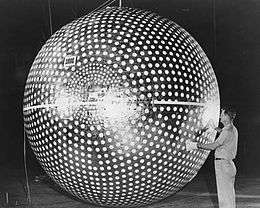Explorer 9
 Explorer 9 before launch | |
| Mission type | Air density |
|---|---|
| Operator | NASA |
| Harvard designation | 1961 Delta 1 |
| SATCAT № | 81 |
| Start of mission | |
| Launch date | 16 February 1961, 13:05:00 UTC |
| Rocket | Scout X-1 ST-4 |
| Launch site | Wallops LA-3 |
| End of mission | |
| Decay date | April 9, 1964 |
| Orbital parameters | |
| Reference system | Geocentric |
| Regime | Medium Earth |
| Perigee | 635 kilometers (395 mi) |
| Apogee | 2,581 kilometers (1,604 mi) |
| Inclination | 38.8 degrees |
| Period | 118.4 minutes |
Explorer 9, known as S-56A before launch, was an American satellite which was launched in 1961 to study the density and composition of the upper thermosphere and lower exosphere.[1] It was a reflight of the failed S-56 mission, and consisted of a 7-kilogram (15 lb), 3.7-meter (12 ft) balloon which was deployed into a medium Earth orbit.[2] The mission was conducted by NASA's Langley Research Center.
Explorer 9 was launched from Launch Area 3 at the Wallops Flight Center, atop a Scout X-1 rocket with the serial number ST-4. It was the first spacecraft launched from Wallops Island to achieve orbit, with one previous attempt having failed. The launch occurred at 13:05:00 UTC on 16 February 1961, and resulted in Explorer 9 being deployed into an orbit with an apogee of 2,581 kilometres (1,604 mi), a perigee of 635 kilometres (395 mi), 38.8 degrees of inclination and a period of 118.4 minutes.[3] It was assigned the Harvard designation 1961 Delta 1.[4]
The second of six identical air density research satellites to be launched, Explorer 9 was the first to successfully reach orbit. It was still operational when the next satellite, Explorer 19, was launched, allowing simultaneous readings to be taken and compared. The spacecraft consisted of alternating layers of aluminium foil and Mylar polyester film. Uniformly distributed over the aluminium surface were 5.1 cm-diameter dots of white paint for thermal control. The sphere was packed in a tube 21.6 cm in diameter and 48.3 cm long and mounted in the nose of the fourth stage of the launch vehicle. Upon separation of the fourth stage, the sphere was inflated by a nitrogen gas bottle, and a separation spring ejected it out into its own orbit. The two hemispheres of aluminium foil were separated with a gap of Mylar at the spacecraft's equator and served as the antenna. A 136 MHz, 15 mW beacon was carried for tracking purposes, but the beacon failed on the first orbit and the SAO Baker-Nunn camera network had to be relied upon for tracking. Power was supplied by solar cells and rechargeable batteries[5] It decayed from orbit on 9 April 1964.[3]
References
- ↑ Smith, Woody. "Explorer Spacecraft Series". NASA History Division. Retrieved 17 June 2010.
- ↑ Wade, Mark. "S-56". Encyclopedia Astronautica. Retrieved 17 June 2010.
- 1 2 McDowell, Jonathan. "Satellite Catalog". Jonathan's Space Page. Retrieved 17 June 2010.
- ↑ McDowell, Jonathan. "Launch Log". Jonathan's Space Page. Retrieved 17 June 2010.
- ↑ Krebs, Gunter. "Explorer: AD". Gunter's Space Page. Retrieved 17 June 2010.